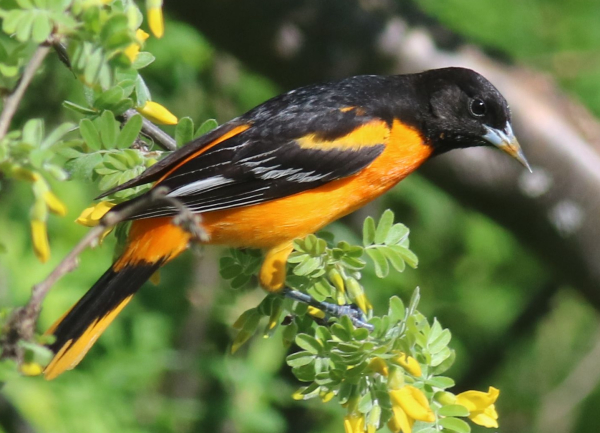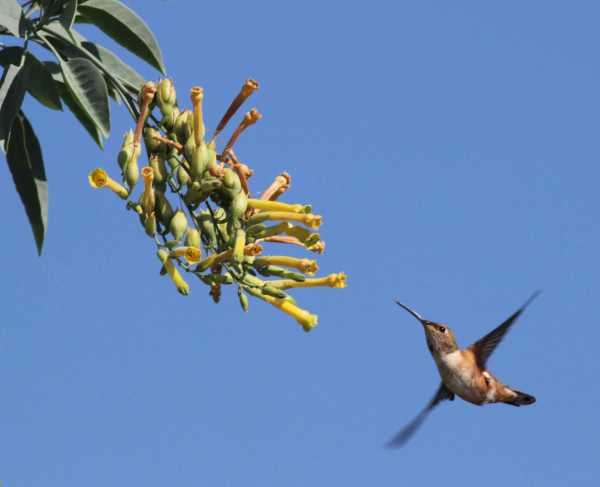
Flowering plants provide nectar and insects that attract songbirds like Baltimore Orioles. Note the pollen accumulated on the beak of this backyard landscaping visitor.

An Allen’s Hummingbird is attracted to tubular flowers that produce nectar (photos by Paul Konrad).
|
Landscaping and gardening for birds is such an important aspect of backyard birding, yet it’s often overlooked with an emphasis on feeding stations and water features. Realistically, feeders, bird baths, and nest boxes should fit into a bird-friendly landscape. We can easily provide areas of habitat to benefit birds with cover, food, and nesting sites. Landscaping is really the glue that holds everything together as a truly attractive, colorful habitat for birds and people. Now is a good time to Review, Plan, & Implement your landscaping.
It’s hard to write about landscaping on a national scale with such a diversity of weather and seasons across the United States and Canada. With lush birding-based gardens growing and blooming across the Sun Belt, the region to the north is still waiting for the first leaves and flowers to materialize.
Even so, one of the main things to keep in mind is that a pretty basic gardening and landscaping adage to plant progressive heights of plants with the shortest in the front and the tallest and thickest in the rear. Position colorful flowering plants as you prefer, with a seasonal progression in mind when and where possible.
Realistically, it’s good to plan for May and June, but also for August and September – and you can do it all at once. And whenever possible, emphasize native flowering plants, trees, and shrubs in your landscaping plans.
As you review, plan, and implement this year’s landscaping plans with an eye toward the future, you may want to map out your yard as it exists now, and add elements as you think things through. You may even want to do some consulting with a gardening friend, or a landscaping pro or two, to get some insights that may take you a step beyond your thinking. You don’t have to follow through with someone else’s suggestions, but it’s worth seeing what insights you might gain from the process.
Be prepared for a May hummingbird invasion – or create one – by providing hummingbird feeders, of course – but also by planting and transplanting flowering plants that hummingbirds prefer. And don’t count out adding large planters of hummingbird-friendly flowering plants with the idea of adding a progression of flowering planter plants. Planters and their placement can add a lot to your yard, and even to the area around your summer feeding station. You may choose to select planters that add some color to your yard in addition to flowers, or use planters that blend in to emphasize the plants themselves.
Actually, you can do much the same with large planters of food plants, such as sunflowers, grapes, and other food plants – even corn. But you may want to consider adding an area or two as bird food gardens, and look into some more permanent shrubs that provide seasonal bird foods, such as chokecherries, dogwoods, persimmons, and even small wild plum trees.
By now, Southern California birders are appreciating the peak nesting season of Anna’s and Allen’s Hummingbirds, while watching for migrating Rufous Hummingbirds at their feeders and flower gardens. Even so, May tends to be a breaking point for landscaping and gardening with birds in mind. With the rainy season ending and a drier period ahead, Southwest birders have an opportunity to plan ahead for the summer, if only to add more shade and maybe a new water feature to the mix as you plan ahead for any summer monsoon rain, or even making a plan for when the rain and cooler temperatures return next fall. In the Southeast, warm humid weather provides a peak growing season that birding gardens can benefit from.
When you have everything in order in your yard, don’t hesitate to give some thought to extending your landscaping efforts to your business, church, or school; thereby impacting another group of birds with your growing gardening prowess. Overall, enjoy the process, and all the progress, growth, and color along the way; and enjoy all the birds your landscaping benefits.
Share your backyard birding experiences and photos at editorstbw2@gmail.com